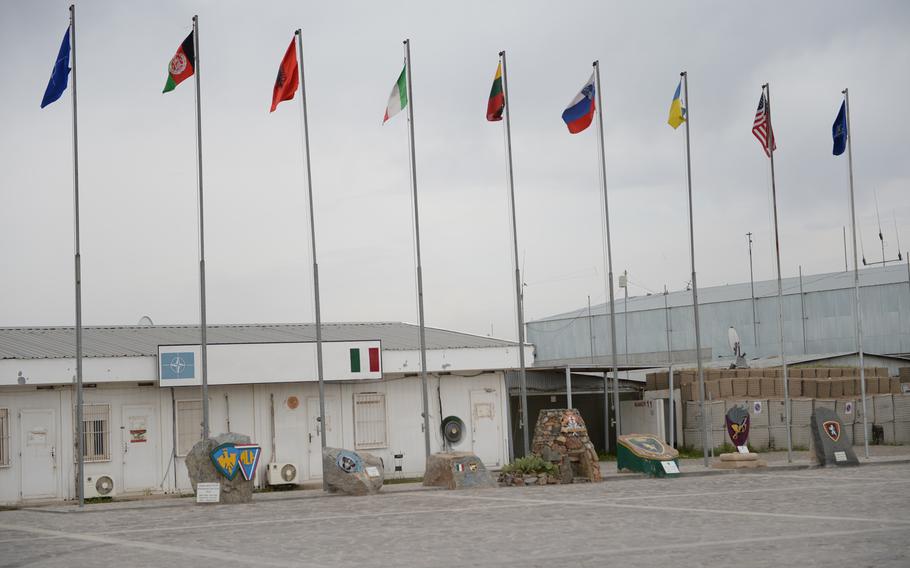
Flags representing NATO, Afghanistan, and coalition forces based at Italian-run Camp Arena in Herat province fly on April 7, 2016. Uncertainty over how long international troops will remain at the base has altered initial plans to hand over the facility to Afghans earlier this year. (Phillip Walter Wellman/Stars and Stripes )
HERAT, Afghanistan — The delayed drawdown of international troops and a revitalized insurgency are forcing officials to strike a difficult balance between security and economic growth as they plan to turn several NATO airfields in the country into commercial hubs.
NATO agreed last year to transfer eight military airfields worth some $10 billion to the Afghans. The Defense Ministry has already taken possession of two airfields — Shindand in Herat province and Shorabak (formerly Bastion) in Helmand province.
Six of the bases are to be turned over to the Afghanistan Airfield Economic Development Commission, which plans to transform them into business zones to attract investors — a move that officials say has the potential to generate billions of dollars in revenue and create hundreds of thousands of jobs in this economically depressed country.
The timing of that turnover is now in doubt because of the decision to delay the further drawdown of U.S. troops amid recent gains by insurgents.
But some see economic development and security for the country as going hand in hand.
“Providing a sustainable security environment not only requires active initiation of a military nature but also sustainable economic development,” said Daoud Sultanzoy, development commission chairman. “Job creation, employment and economic vitality will prevent those who want to capitalize on the weakest links of a society from doing so. It’s just as important as troops.”
Under the plan, the airfields to be used by the Afghan military will also be used to provide enhanced civilian services, such as commercial and cargo flights and office space.
Initially, the airfields were to be handed over to the Afghan military and the development commission in the first quarter of this year, when only 5,500 American troops were expected to be stationed in the country. But Washington decided late last year to keep U.S. troop levels at about 10,000 until the beginning of next year, thus delaying the transition.
In light of the situation, national and local leaders say they had begun to explore the option of partial transfers at some of the airfields.
Mohammad Asif Rahimi, the provisional governor of Herat province, called for more clarity during a meeting earlier this month that marked the opening of the development commission’s local chapter.
“We must know what percentage of the airport (military forces) need. When we start to develop, how many meters do we need to accommodate Resolute Support? Until now we don’t know,” he said, speaking at Italian-run Camp Arena, which includes the Herat airfield.
NATO has pledged full support for the initiative.
“Our presence here will try to hamper as less as possible the development of the economic zone,” said Italian Commander Brig. Gen. Mauro D’ubaldi, whose troops along with other coalition forces are currently stationed at the Herat airfield. He acknowledged the importance of transferring the airfields into “possible business and possible money.”
Herat is likely to become the first economic zone to open. Since last July, local officials have been preparing for the hand-over, and they said they had investors lined up four months ago.
Each airfield is said to offer unique investment opportunities. In Heart, for example, saffron and marble are to be the primary exports, and improved air links could generate additional revenue, leaders say.
New regional officers, or chapters, like the one in Herat are being established so authorities in the capital can better manage the nationwide project. Chapter officials will update Kabul regularly on their activity.
A Kandahar chapter was established late last year, and a chapter in the northern city of Mazar-i-Sharif is scheduled to open next month. The fourth chapter near the eastern town of Jalalabad will open later this year. The two remaining airfields are in the capital.
A reduction of coalition troops after the declared end of combat operation in December 2014 has taken a heavy toll on Afghanistan’s economy. The unemployment rate is about 40 percent, up from 25 percent in 2014, and growing, according to the United Nations.
But uncertainty over troop numbers is not the only hurdle the project faces. The biggest concern is security, said the development commission’s Sultanzoy, both in the country and at the airfields.
“It’s the first thing on everybody’s mind,” he said.
Sultanzoy said he was “openly happy” Obama kept troops in Afghanistan.
“Timetables in Washington based on political calendars do not reflect realities on the ground here in Afghanistan,” he said. “If we really want so show our enemies that we are serious and we want to fight the war on terror, then we should address the ground realities where the war is being fought.”
Still, he said, there also must be solutions to ensure the success of the airfields project.
Army Col. Thomas J. Tickner, director of joint engineers at Combined Security Transition Command–Afghanistan said the extended troop presence and corresponding delay in handing over the airfields could ultimately lead to the success of the project because it will give everyone involved more time to tackle any obstacles standing in the way.
Like Sultanzoy, Tickner said he was confident that the project would eventually succeed. “This is a game changer for Afghanistan.”